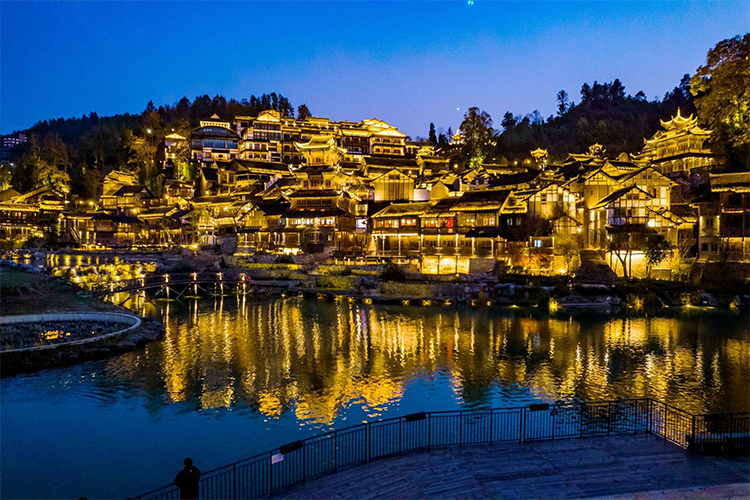Experience Wujiangzhai’s Intangible Heritage: Immersive Night Village in Guizhou
Discover Wujiangzhai, Guizhou: Immersive Night Village
Introduction:
When night falls, hundreds of drones weave a shimmering galaxy above the Wujiang River, stilt houses are outlined in warm light, and the clear voices of Miao young women drift across the valley—this is Wujiangzhai. Tucked into northern Guizhou’s hills, the village blends terraced river scenery, living intangible heritage, and modern resort comforts. Unlike noisy theme parks, Wujiangzhai replaces mechanical clamor with the sound of flowing water and swaps LED walls for naturally dyed fabrics—offering culturally curious travelers a living folk museum and an immersive night-tour experience.
1. Soul Positioning: A Village Where Water, Mountains and People Converge
“Open the window to rice terraces; rest with Miao songs at your pillow” best describes Wujiangzhai. Spanning 5.08 square kilometers, the resort cleverly uses tributaries of the Wujiang River to link 12 restored northern Guizhou residential clusters into a chain of lived-in scenes. Walking on slate lanes feels like stepping into a time tunnel: mortise-and-tenon stilt houses shelter artisans making handmade paper; corner dye workshops smell of indigo; on the old opera stage, nue opera masks flip with drumbeats. Crucially, these are not static exhibits—you can learn embroidery from a Miao aunt, jump into rice paddies to catch fish, and become a cast member in this ecological cultural theater.
2. Complete Guide to the Four Main Zones
2.1 Core Visitor Area: A Folk Feast from Dawn to Night
Riverside Food Street is the first stop for flavor exploration—try the sour-soup fish hotpot made with Wujiang fish; about 60 yuan per person will let you eat liberally. In the afternoon, the intangible heritage workshop area offers hands-on dyeing for around 20 yuan, so you can create a one-of-a-kind travel keepsake. After sunset, don’t miss two marquee experiences:
– Huilong Island Night Tour (starts 19:30): Take a bamboo raft through misty waters as riverside projections tell Miao creation epics;
– Drone Light Show (21:00): 200 drones morph into phoenixes, dragon boats, and more—best viewed from the opera stage square.
2.2 Resort Hotel Zone: Sleep Inside a Landscape Painting
Miao King Hotel (800–1,200 yuan per night) blends modern comfort with Miao silver motifs; some rooms have viewing terraces. For better value, Mushan Hotel (500–800 yuan) lets you open the window to a sea of clouds rolling over the terraces at dawn. Stay at least one night to experience the village’s full rhythm as it transitions from lively to tranquil.
2.3 Countryside Leisure Zone: A Family-Friendly Relaxation Hub
Families can spend half a day here: spring rice planting and autumn harvesting are seasonal activities (booking required), or relax at a terrace-side café with a cup of Rosa roxburghii juice while watching egrets skim the water. A hidden bonus is the Bamboo Grove Playland, where natural wooden climbing frames blend seamlessly with the forest.
2.4 Highland Adventure Zone: A Secret Base for Adventurers
Campers love the 900-meter-high stargazing campsite (tent rental 300 yuan per tent); the outdoor challenge area’s zipline offers panoramic views over the entire village. The September mountain hiking race is a great chance to meet local outdoor enthusiasts.
3. Local Insiders’ Tips
– Best photo spot: Huilong Island arch bridge at 7:00 AM—mist and morning light give photos an ink-wash painting effect;
– Avoid crowds: Weekend afternoons from 15:00–17:00 are peak tour group times—hike in the highlands instead;
– Hidden experience: Book a secret bamboo raft with a steward for a fee—boatmen will take you to waterfalls off the regular route;
– Save money: Buy the 198-yuan Intangible Heritage Pass to try tie-dyeing, papermaking, and Miao embroidery with priority access.

4. Practical Information
Tickets and Hours:
– Day ticket 80 yuan (09:00–16:00), Night ticket 60 yuan (16:00–22:00), Combined pass 120 yuan
– Some outdoor activities pause in winter (Dec–Feb); summer adds events like water-splashing festivals
Getting There:
– About a 1-hour taxi from Zunyi High-Speed Rail Station (approx. 150 yuan), or take the hourly tourist shuttle bus (35 yuan per person)
– For self-driving, navigate to “Wujiangzhai East Visitor Center”; parking is 20 yuan per day
Language and Payment:
– Key signs are bilingual (Chinese and English); hotel front desks offer basic English service
– Carry some cash—some stalls accept only WeChat Pay (staff can usually pay on your behalf)
5. Recommended Itineraries
Cultural Deep One-Day Tour: Morning at Zunyi Conference Site → Afternoon arrival at Wujiangzhai → Intangible heritage workshops → Overnight at Miao King Hotel
Nature and Leisure Two-Day Tour: Day 1 full day at Wujiangzhai → Day 2 drive 1.5 hours to Shier Beihou Shuanghe Cave to explore Asia’s longest solutional cave

Conclusion:
On Guizhou’s travel map, Wujiangzhai is a gem not yet overpolished. There are no roller coasters, but the single-bamboo rafting mastery—standing on one leg in the river—quickens the pulse more than any theme-park drop. The village doesn’t sell plastic trinkets; a Miao girl’s hand-sewn embroidered panel will be the warmest keepsake in your suitcase. As urban amusement parks converge in style, this lived-in mountain village demonstrates the true meaning of immersive experience in the simplest, most authentic way.


